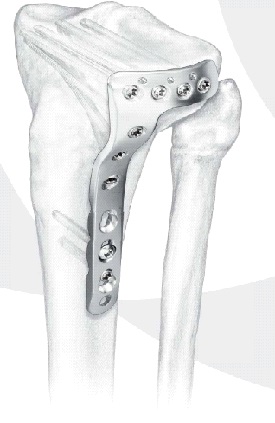The 3.5 mm LCP Medial Distal Tibia Plate, without tab is part of the DePuy Synthes LCP System that merges locking screw technology with conventional plating techniques.
Fixation with the 3.5 mm LCP Medial Distal Tibia Plate without tab has many similarities to traditional plate fixation methods, with a few important improvements. Locking screws provide the ability to create a fixed-angle construct while using standard AO plating techniques. Locking capability is important for fixed-angle constructs in osteopenic bone or multifragment fractures where screw purchase is compromised. These screws do not rely on plate-to-bone compression to resist patient load, but function similarly to multiple, small, angled blade plates.
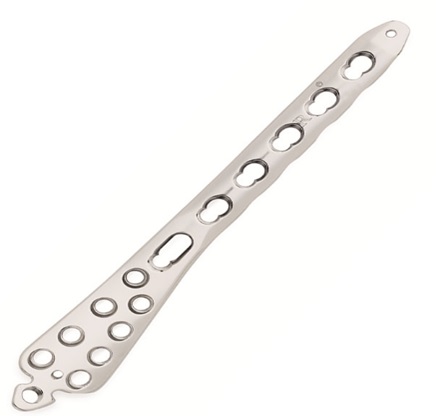
The VA-LCP Condylar plate 4.5/5.0 is part of the VA-LCP periarticular plating system which merges variable angle Locking Screw Technology with conventional plating techniques. the VA-LCP Condylar plate 4.5/5.0 system has many similarities to standard locking fixation methods, with a few important improvements. Variable angle Locking screw provide the ability to create a fixed-angle Constractions (Which provides advantages in osteopenic bone or multifragmentary bridge-plated Fractures) while also providing the freedom to choose the screw trajectory prior to “fixing” the angle of the screw (trajectories that can diverge from the central axis of the plate hole).
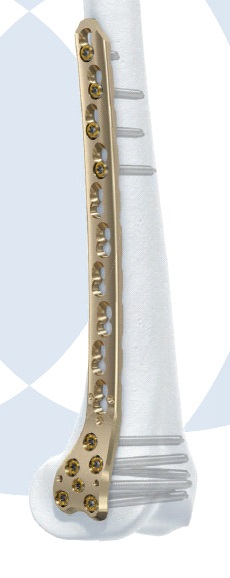
Versatile Proximal locking options:
Three innovative locking options, in combination with cancellous bone locking screws, increase the stabilitymof the proximal fragment for proximal third fractures.
two state of the art medio-lateral (ML) locking options enable primary compression or secondary controlled dynamization.
Anatomic bend for ease of nail insertion
Titanium alloy TAN* for improved mechanical and fatigue prpoerties
Cannulated Nail ( from 8mm to 13mm ) for reamed or unreamed techniques, enabling nail insertion over guide wire
The 2.5mm or 3mm vball tipped guide wires may be removed through the nail and insertion handle assembly
Solid nails (from 8mm to 10mm) for unreamed technique.
Distal oblique locking option to prevent soft tissue damage and increase stability of the distal fragment
Two ML and one antero-posterior (AP) locking options for stability of the distal fragment

The TOMOFIX Osteotomy system provides stable fixation of osteotomies close to the knee and consists of five plates designed for specific parts of anatomy: TOMOFIX medial high Tibia Plate,TOMOFIX Medial high tibia plate, TOMOFIX Lateral Distal femur plate , and TOMOFIX Medial Distal Femur Plate.
All of the plate in the TOMOFIX Osteotomy system are designed according to Locking Compression Plate System principles. The Fixed-angle constractions throughout the plate, improving retention of screw in the plate and in cortical bone. Dynamic compression can be achieved by eccentric insertion of 4.5 mm titanium cortex screw in the dynamic compression unit (DCU) portion of the hole. The plates are available in titanium, range in length from 102 mm to 141 mm, and accept 5.0 mm titanium locking screw and 4.5 mm titanium cortex screws.
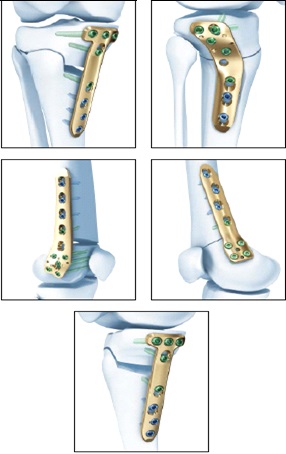
The 3.5mm LCP Medial Proximal Tibia Plate is part of the Depuy Synthes Locking Compression Plate (LCP) system that merges locking screw technology with conventional plating techniques.
The 3.5mm LCP Medial Proximal Tibia Plate is available in stainless steel or taitanium and has a limited contact shaft profile. The head and neck portion of the plate accept 3.5mm conical screw . The screw hole pattern allows a raft of subchondral locking screw to buttress and maiintain reduction of the articular surface. This provides fixed angle support to the tibial plate.
The Locking Compression Plate has combi holes in the plate shaft that combine a dynamic compression unit (DCU) holes with a locking screw hole. The combi hole provides the flexibility of axial compression and locking capability throughout the length of the plate shaft.
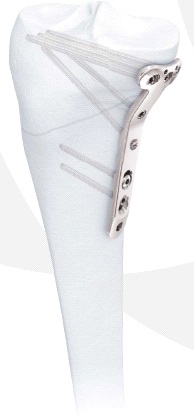
The LCP Distal femur plates are based on the LCP System. The shaft portion of the plate features combi holes and head features threaded holes. The shape of the plates is based on the design of the Distal Femur LISS plates. The plates are available with 5,7,9,11 and 13 holes for both the left and right femur.

3.5 mm LCP Distal Tibia T-Plates are part of the DePuy Synthes locking compression plate (LCP) system.
The 3.5 mm LCP Distal Tibia T-Plates are part of the DePuy Synthes LCP System that merges locking screw technology with conventional plating techniques.
The plates are available in stainless steel and long plates feature a limited-contact shaft profile. The Combi holes allow fixation with locking screws in the threaded section for angular stability, and cortex screws in the dynamic compression unit (DCU) section for compression. The fixed-angle construct provides advantages for small distal metadiaphyseal segments where traditional screw fixation may be limited. This design provides angular stability similar to a blade plate while maintaining ease of insertion.
The 3.5 mm LCP Distal Tibia T-Plate construct features four locking, rafting screws parallel to the joint surface along with locking, strut screw options providing additional support in the distal region of the tibia. The plate accepts 2.7 mm and 3.5 mm cortex screws, 3.5 mm locking screws and 4.0 mm cancellous bone screws.

Osteotomy System, provides stable fixation of closed-wedge osteotomies close to the knee. The TomoFix Medial Distal Femur Plate is designed according to the locking compression plate (LCP) principles. The distal plate head features four threaded locking holes that were designed to adapt to the anatomy of supracondylar femur. The proximal plate shaft features Combi holes that accept both cortex and locking screws. The TomoFix Medial Distal Femur Plate is made of commercially pure titanium.
The TomoFix Osteotomy System is a comprehensive plating system for stable fixation of osteotomies around the knee. The TomoFix Osteotomy System consists of five plates designed for specific parts of the anatomy:
TomoFix Medial High Tibia Plate
TomoFix Medial High Tibia Plate, small
TomoFix Lateral High Tibia Plate
TomoFix Lateral Distal Femur Plate
TomoFix Medial Distal Femur Plate
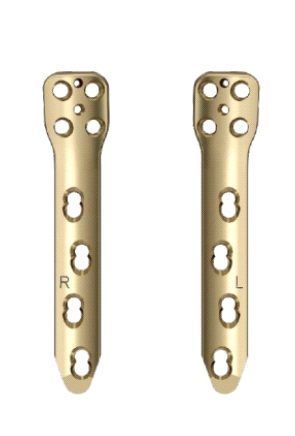
The TomoFix Lateral Distal Femur Plate, part of the TomoFix Osteotomy System, provides stable fixation of osteotomies close to the knee. The TomoFix Lateral Distal Femur Plate is designed according to the locking compression plate (LCP) principles and features both threaded locking and Combi holes. The TomoFix Lateral Distal Femur Plate is made of TAN (Ti-6Al-7Nb).
The TomoFix Osteotomy System is a comprehensive plating system for stable fixation of osteotomies around the knee. The TomoFix Osteotomy System consists of five plates designed for specific parts of the anatomy:
TomoFix Medial High Tibia Plate
TomoFix Medial High Tibia Plate, small
TomoFix Lateral High Tibia Plate
TomoFix Lateral Distal Femur Plate
TomoFix Medial Distal Femur Plate

The 3.5 mm LCP®Percutaneous Instrument System consists of a comprehensive series of aiming arms and instrumentation to facilitate the percutaneous, submuscular insertion of various plates.
The 3.5 mm LCP Percutaneous Instrument System provides common instrumentation throughout the system including:
Screwdrivers
Threaded drill sleeves
Drill bits
Locking/neutral guides
Compression sleeves
Trocars
Pull reduction devices
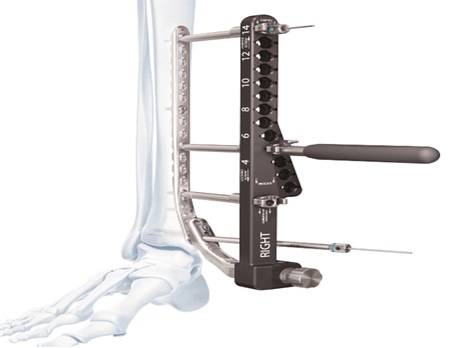
Combi hole allows the surgeon to choose between conventional plating techniques, locked plating techniques, or a combination of both.
Threaded hole section for locking screws provides ability to create fixed-angle constructs.
Smooth Dynamic Compression Unit (DCU) hole section for standard screws allows for load (compression) and neutral screw position.
Limited-contact plate design reduces plate-to-bone contact, thus limiting vascular trauma.
The DePuy Synthes 3.5 mm Locking Compression Plate (LCP) System is indicated for fixation of fractures, osteotomies and non-unions of the clavicle, scapula, olectranon, humerus, radius, ulna, pelvis, distal tibia, fibula, particularly in osteopenic bone for adult patients.
The Synthes 4.5 mm Locking Compression Plate (LCP) System is indicated for fixation of various long bones, such as the humerus, femur and tibia and for use in fixation of peri-prosthetic fractures, osteopenic bone and fixation of non-unions or malunions in adult patients
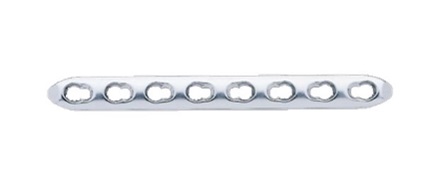
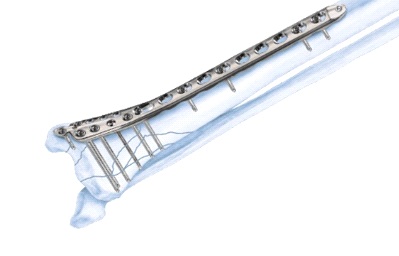

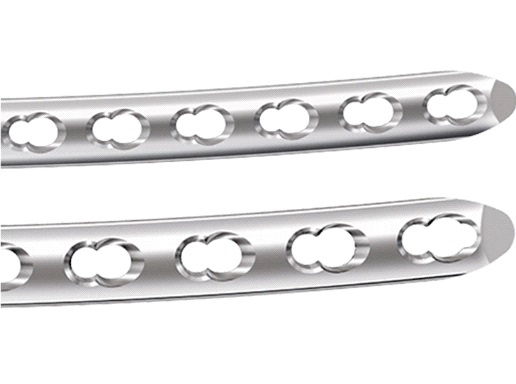
The Synthes 3.5 mm VA-LCP Proximal Tibia Plate is part of the VA-LCP Periarticular Plating System which merges variable angle locking screw technology with conventional plating techniques.
The 3.5 mm VA-LCP Proximal Tibia Plate System has many similarities to standard locking fixation methods, with a few important improvements. Variable angle locking screws provide the ability to create a fixed-angle construct while also allowing the surgeon the freedom to choose the screw trajectory before “fixing” the angle of the screw. A fixed-angle construct provides advantages in osteopenic bone or multifragmentary bridge-plated fractures where screws do not rely on plate-to-bone compression to resist patient load.
The 3.5 mm VA-LCP Proximal Tibia Plate has variable angle holes in the plate head and neck, along with variable angle Combi holes in the plate shaft that combine a dynamic compression unit (DCU) hole with a variable angle locking screw hole. The variable angle Combi hole provides the flexibility of axial compression and variable angle locking capability throughout the length of the plate shaft.
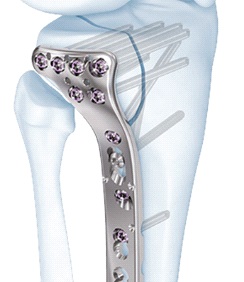
The 3.5 mm LCP Posteromedial Proximal Tibia Plate is available in stainless steel or titanium and has a limited-contact shaft profile. The head and neck portions of the plate accept 3.5 mm locking, conical and cortex screws or 4.0 mm cancellous bone screws.
The Synthes 3.5 mm LCP Posteromedial Proximal Tibia Plate is part of the Locking Compression Plate (LCP) System, which merges locking screw technology with conventional plating techniques. The Locking Compression Plate (LCP) has Combi-holes in the plate shaft which combines a Dynamic Compression Unit (DCU) hole with a locking screw hole. The Combi-hole provides flexibility of axial compression and locking capability throughout the length of the plate shaft.
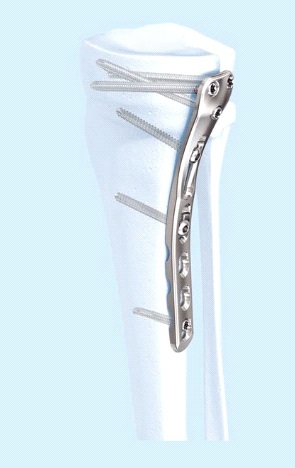
The Synthes 4.5 mm LCP Proximal Tibia Plate is part of the LCP Periarticular Plating System, which merges locking screw technology with conventional plating techniques. The 4.5 mm LCP Proximal Tibia Plate has many similarities to traditional fixation methods, with a few important improvements. The technical innovation of locking screws provides the ability to create a fixed-angle construct while using familiar AO plating techniques. Locking capability is important for fixed-angle construct in osteopenic bone or mulitfragment fractures where screw purchase is compromised.
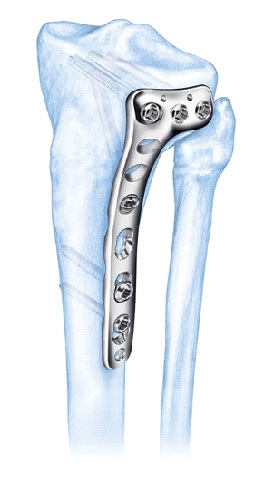
The 3.5 mm LCP Proximal Tibia Plates have a limited-contact profile. The head and neck portions of the plates accept 3.5 mm StarDrive™ Recess Locking Screws. The screw hole pattern allows a raft of subchondral locking screws to buttress and maintain reduction of the articular surface. This provides resistance to local depression loads in addition to the stability of the fixed angle construct created by locking the screws into the plate.
The Synthes 3.5 mm LCP Proximal Tibia Plate and 3.5 mm LCP Proximal Tibia Plate, Low Bend are part of the Locking Compression Plate (LCP) System, which merges locking screw technology with conventional plating techniques. The Locking Compression Plate (LCP) has Combi-holes in the plate shaft which combine a dynamic compression unit (DCU) hole with a locking screw hole. The Combi-hole provides flexibility of axial compression and locking capability throughout the length of the plate shaft.
